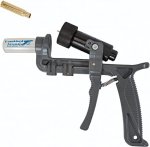So... for those who do wet tumble using SS media... do you ever use any kind of preservative in the drum with the media when storing it?
It'd been a while since I'd used my wet tumbling setup, and when I cracked the lid on the drum after tumbling the first batch of brass, the water was more brown than black. No more rusty water thereafter, but there's still a pretty good rust spot/stain on the rubber liner at the bottom of the drum.
It'd been a while since I'd used my wet tumbling setup, and when I cracked the lid on the drum after tumbling the first batch of brass, the water was more brown than black. No more rusty water thereafter, but there's still a pretty good rust spot/stain on the rubber liner at the bottom of the drum.



